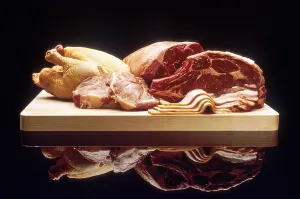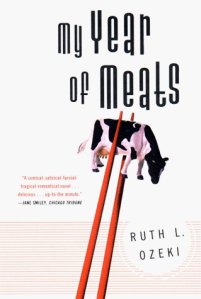Ruth Ozeki’s My Year of Meats follows unemployed documentarian Jane Takagi-Little on her experience working as a producer for a Japanese TV show called My American Wife, which is sponsored by a Texas-based meat industry lobby organization called Beef-Ex. To continue the pattern of westernization in Japan, My American Wife features American wives demonstrating the steps to simple American recipes that contain red meat and can be performed at home for a family dinner. At the typical American family dinner table, red meat represents the main dish that unites each family member to bond with each other by sharing the dish. In order to establish a bond for the Japanese family during dinnertime, Jane Takagi-Little emphasizes the modern American tradition of serving red meat at the dinner table.
As the main purpose of the TV Show, red meat, instead of the American housewife, is the star of My American Wife. Sponsored by Beef-Ex, My American Wife wants Japanese housewives to “feel the hearty sense of warmth, of comfort, of hearth and home – the traditional family values symbolized by red meat in rural America” (Ozeki 8). Normally, the typical Japanese family indulges in light-tasting dishes, such as seafood, rice, soup, and vegetables. Although these dishes are light in flavor, the Japanese consider this cuisine as a commonplace in their culture. However, red meat, an “attractive, appealing, all-American dish,” gives the Japanese a sense of both westernization and modernization with the appeal of the American culture. As Japan becomes more of a Western-cultured civilization with the increase of American fast food places and red meat at the markets, it is reasonable for home-cooked meals to include the use of red meat as a main dish.
In order for the audience to gain interest in American red meat cuisine, Ruth Ozeki’s word choice to describe the purpose of the show creates a warm and persuasive tone. For example, the passage emphasizes how red meat brings the “hearty” sense of “warmth,” “comfort,” “hearth,” and “home.” (Ozeki 8) Instead of having the normal Japanese dinner, the Japanese should try something that would provides tons of flavor while producing the pleasant feeling of comfort while consuming the dish made of red meat. Ozeki wants to appeal to the Japanese housewives so their family members can intensify the feeling of comfort at home while enjoying their meal as a family. By intensifying this comfortable feeling, this allows family members to endure in bonding with sharing the amiability of their main dish of hearty red meat.
By emphasizing the value of bonding as a family as well as the use of red meat at the dinner table, the American tradition of the culinary concoction of red meat allows the Japanese housewife and her family to experience the ways at the dinner table of the modern American family. As a rising country in the westernization of cuisine, utilizing red meat in home-cooked meals allows the typical Japanese family to meet the modern expectations of the modern westernized Japanese culture.




